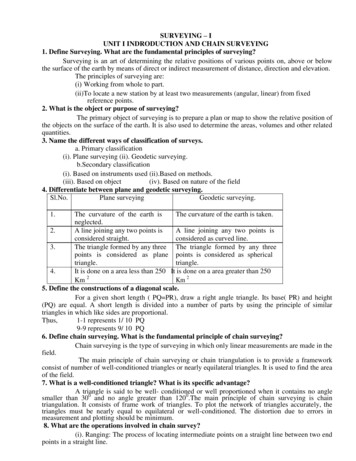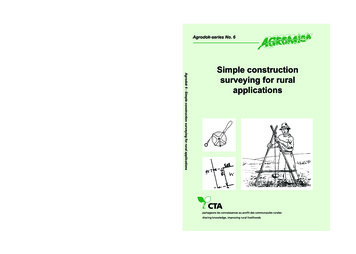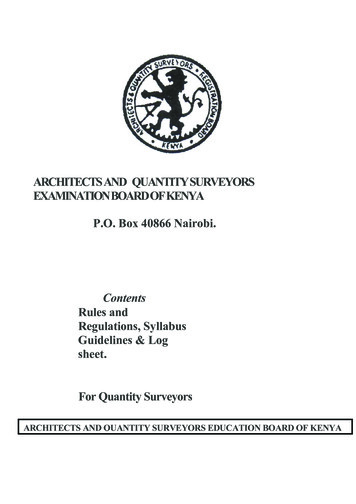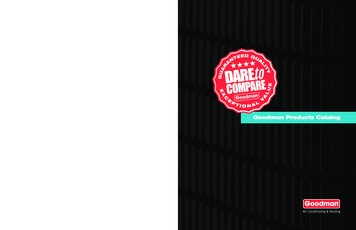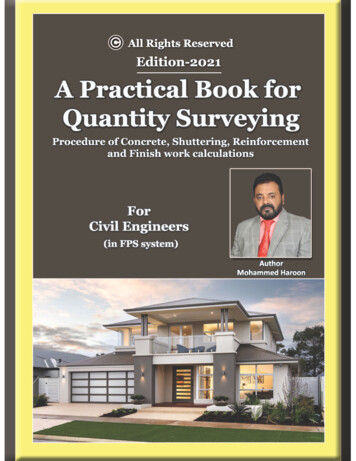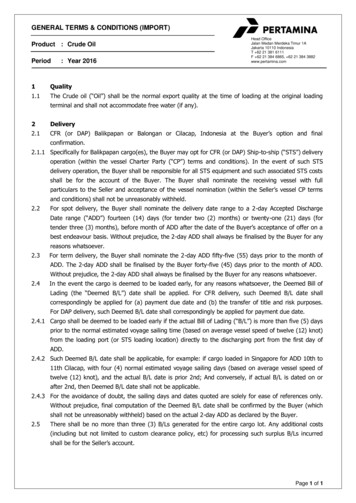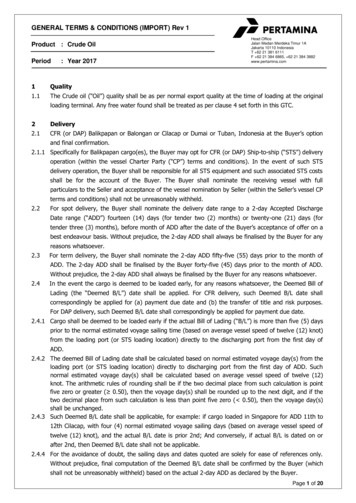
Transcription
CE 208Quantity SurveyingDepartment of Civil EngineeringAhsanullah University of Science and TechnologyNovember, 2017
Department of Civil EngineeringAUSTPrefaceQuantity surveying refers to the estimation of materials as well as the final cost estimation for anyproject. Cost estimating is one of the most important steps in project management. Cost estimationestablishes the base line of the predicted project cost at different stages of development of theproject. This lab manual intends to introduce the students with the estimation of the moderate sizestructures, i.e. residential building, culvert, underground water reservoir, retaining wall as well asestimation for excavation. The examples are imaginary structures but the basic process of thecalculations will pave the way to estimate real structures.The authors highly indebted to their colleagues for their constant support and guidance during thecourse of preparing this manual. In addition, estimation concepts were taken from EstimatingBuilding Costs for the Residential and Light Commercial Construction Professional, by Wayne J.el. Pico, Estimating for Residential Construction by David Pratt. Besides, practical estimatingaspects were studied from Consultants Estimating Manual, Division of Capital Asset Management,Commonwealth of Massachusetts (2006) while the pictures, where referenced, were collected fromthe internet.Nafis Anwari, LecturerLecturerDepartment of Civil EngineeringAhsanullah University of Science and TechnologyMd. Hossain Nadim, LecturerLecturerDepartment of Civil EngineeringAhsanullah University of Science and Technology
Department of Civil EngineeringAUSTTable of ContentsPage No.Part 1: Introduction to Quantity Surveying .11.1 Study of Drawings .11.2 Bill of Quantities (BoQ) .11.3 What is Specification? .21.4 Necessity of Specifications .21.5 Main Items of Works of Building: .31.6 What is Analysis of Rate? .41.7 Purpose of Rate Analysis .51.8 Factors affecting the Rate analysis: .5Part 2: Reinforcement Estimation of a RCC Slab .62.1 Reinforcement used in the RCC .62.2 Cover and Clear Cover in RCC .62.3 Hook .72.4 Type of Reinforcement Used in Slab .82.5 Meaning of Legends.82.6 Length of a Cranked Bar .92.7 Number of Reinforcement (Alternately Cranked Distribution) . 102.8 Worked Out Problem . 12Part 3: Estimation of a Residential Building . 143.1 Basic Calculation of Estimation of Construction Materials . 143.2 Unit Weight of Some Important Materials . 153.3 Assignment . 153.4 Worked Out Problem . 17Part 4: Estimation of RCC Slab Culvert . 304.1 Culvert . 304.2 Use of Culvert . 304.3 Different Types of Culvert . 314.4 Slab Culvert . 33
Department of Civil EngineeringAUST4.5 Components of a typical RCC Slab Culvert . 334.6 Worked Out problem . 35Part 5: Estimation of an Underground Water Reservoir . 435.1 Worked Out Problem . 43Part 6: Estimation of a Retaining Wall . 476.1 Retaining wall. 476.2 Types of Retaining wall . 476.3 Components of a typical RCC retaining wall . 486.4 Worked Out Problem . 49Part 7: Estimation of a Septic Tank . 537.1 Definition of Septic Tank . 537.2 Components of Septic Tank . 537.3 Worked Out Problem . 54Part 8: Earthwork Excavation for Roadway . 578.1 Calculation of Volume . 578.2 Measurement from Cross Sections . 578.3 Terms and Abbreviations . 578.4 Mid-section formulae (Average Height Method) . 588.5 Trapezoidal Formula/ Average End Area Method / Mean-Sectional Area Method. 588.6 Prismoidal formula . 598.7 Worked Out Problem . 59Part 9: Estimation of a Roof Truss. 669.1 Types of Truss . 669.2 Basic Terminologies of a truss . 679.3 Worked Out Problem . 69Part 10: Uses of Software in Construction Estimation . 7210.1 Introduction. 7210.2 Software Used in Quantity Surveying . 7210.3 QuickMeasure OS . 72References . 82
Part 1: Introduction to Quantity SurveyingQuantity surveying is an assessment of the cost based on certain rates of materials and labour. Anestimate should be realistic assessment should be made on actual conditions of market. Estimationis undoubtedly one or the most important aspects of a construction project. A good estimation savesthe expenditure to a great extent and ensures optimum use of materials. Estimation is very muchtechnical. It requires good knowledge on structural design, properly or engineering materials andessentially practical experience.Essentials in a good Quantity Surveyor: What are the essentials in a good Quantity Surveyor? Hemust be able to describe clearly in proper unambiguous language the requirement of the Architectand so arrange his bill of quantities (BoQ) that the Builder can quickly, easily and accurately arriveat the estimated cost or the work. The Quantity Surveyor must have a sound knowledge or buildingmaterials and construction and or customs prevailing in the trade. He must be accurate in his workand calculations.1.1 Study of DrawingsIt would be extremely premature if an attempt were to be made at the taking on: immediately onreceipt of the drawings. Much has to be accomplished before proceeding to take out quantities fromthe drawings. Many errors can be avoided if the following steps are taken before entertaining anythought of taking off:(1) Look over the drawings and attempt to visualize the work entitled.(2) Study the, are in agreement with one another.(3) Check drawings carefully to see that plans, elevations, sections and details, if any the dimensionson the drawings to make sure that each overall dimension agrees with the total room dimensions. Ifserious errors arc discovered, the architect should be informed; but if the discrepancy is due to theresult of slight arithmetical error, the drawings should be corrected.(4) If the dimensions do not exist in some places, then it is always better to write them in. Thesemissing dimensions should be worked out from other dimensions, as far as possible, scaling themfrom the drawing being the last resort.1.2 Bill of Quantities (BoQ)When one wants to buy a table, he ask the cabinet maker as to what is would cost. The cabinetmaker before giving the cost would like to know the detailed specification of the table, i.e., its sizelength, breadth, height, design, type of timber and the finish required. Once the specification isknown the cabinet maker will give the value of the table by working out cost of materials andlabour required and adding his overhead and profit. Similarly, a prospective building owner wantsto know before placing the order that what the cost or his building would be. In order to work outthe east of a building, detailed quantities have to be worked out in accordance with the requirementCE 208: Quantity SurveyingPage 1 of 83
Department of Civil EngineeringAUSTof the Standard Method of measurement and price by the Builder. These quantities when collectedtogether into a bill, form a bill of quantities. The advantages of a bill or quantities are as follows:(1) It forms a common basis for competitive tendering which is necessary to obtain a reasonablevalue tor consideration.(2) It forms in itself a basis of rates for measured work which can be used in the contract for valuationof variations and final account.(3) It is used in building operations for the completion of interim payments.The following points are essential in the production of good bill of quantities:(1) A good knowledge of building construction as without this the correct interpretation of thedrawings would not be possible.(2) Accuracy and neatness in measuring and setting out.(3) A thorough knowledge of writing descriptions in concise and clear language which will translatethe drawings into words.1.3 What is Specification?A Specification is a special description or a particular subject. An engineering specification containsdetailed description or all workmanship and materials which are required to complete an engineeringproject in accordance with its drawings and details. The technical drawings of a structure willshow, the proportions and relative positions of the various components of the structure. It is notoften possible to furnish the information on the drawings, regarding the quality or materials to beused and the quality of workmanship to be achieved during construction, due to shortage of space.This data regarding the materials and workmanship is conveyed in a separate contract document,which is known as the "specifications" for the work. Thus the drawings with the specifications “willcompletely define the structure”. The “specification” is furnished separately along with the drawingsand is an essential part of all engineering contracts.1.4 Necessity of SpecificationsThe necessities of specifications are as follows:(a) The cost of unit quantity of work is governed by its specification.(b) Specifications of a work are required to describe the quality and quantity or different materialsrequired for a construction work and is one of the essential contract documents. Thus a contractorcan make a programme to procure the materials required for a project and the owner can checkthe quality of materials conforming to the specification avoiding dispute with the contractor.(c) This also specifies the workmanship and the method of doing the work. Thus specification of awork serves as a guide to the supervising staff of the contractor as well as to the owner to executethe work to their satisfaction.(d) A work is carried according to its specification and the contractor is paid for the same. Anychange in specification changes the tendered rate.CE 208: Quantity SurveyingPage 2 of 83
Department of Civil EngineeringAUST(e) As the rate or a work is based on specification, a contractor can calculate the rates of variousitems of works in a tender with his procurement rates of materials and labour. Thus tender paperwithout specifications of works is baseless, incomplete and invalid.(f) Specification is necessary to specify equipment, tools and plants to be engaged for a work andthus enables to procure them beforehand.(g) The necessity of specification is to verify and check the strength of materials for a work involvedin a project.(h) Specification is an essential contract document and required for arbitration of court cases1.5 Main Items of Works of Building:As per ASTM UNIFORMAT II Classification for Building Elements (ASTM E1557-09, 2015),the main items of works of building are:1. Earthwork: Earthwork in excavation and earthwork taken out accurately under different items2. Concrete in Foundation: Foundation concrete consists of lime concrete or weak/lean cementconcrete. The proportion of cement concrete In foundation may be 1: 4: 8 or 1: 5: 10.3. Brick Flat Soling: When the soil is soil or bad.' one layer of dry brick or stone soling is appliedbelow the foundation concrete. This soling layer is computed in square units specifying thethickness.4. Damp Proof Course: DPC usually of 2.5 cm (1 inch) thick rich cement concrete 1: 1.5:3 or 2 cm(.75 inch) thick rich cement mortar 1 :2, mixed with standard water proofing material, is providedat the plinth level to full width of plinth wall and the quantities are computed in square units. Itis not provided at veranda openings.5. Masonry: Foundation and plinth masonry is taken under one item, and masonry in superstructureis taken under a separate item. In storied building, the masonry in each storey is tabulatedseparately. Proper deductions arc made for openings as doors, windows, lintels etc. Archmasonry work is taken out separately.6. Arch Masonry Works: Masonry work in arches is calculated in cubic units separately bymultiplying the mean length of the arch by the thickness of the: arch and by the breadth of thewall.7. Lintels over Openings: Length of lintel is equal to the clear span plus two i hearings. If thedimension of bearing is not given, the bearing may be taken as 1 same as the thickness of lintelwith a minimum of 12 cm. (4.50 inch).8. RCC & RB Work: The quantities in roof or floor slab, in beams, lintels, columns, foundationsare calculated in cubic units exclusive of steel: reinforcements and its bending but inclusive ofcentering and shuttering and fixing and binding reinforcement in position. The reinforcementincluding its bending is taken up separately under steel works. For this purpose, 0.6% to 1 % ofRCC by volume may be taken for steel.9. Flooring and Roofing:(i) Ground Floor: The base lime concrete and floor finishing of CC or stone or marble ormosaic etc. are usually taken as one job or one item and the quantity is 'calculated in squareCE 208: Quantity SurveyingPage 3 of 83
Department of Civil EngineeringAUSTunits. The length and breadth are the inside dimensions from wall to wall of superstructure.(ii) lst floor, 2nd floor etc.: Supporting structure is taken separately in cubic units as RCC andthe nom finishing is taken separately in sq units as 2.5 cm or 4 cm (1 inch) or 1.5 inch) CCor marble, mosaic etc.10. Plastering and Pointing: Plastering usually 0.5 inch thick s calculated in square metres. Whilededucting, the following rules are generally followed: For small openings up to 0.5 sq. m (5 sq. ft) no deduction is made and at the same time noadditions are made for jambs, soffits and of sills of these openings. For opening exceeding 0.5 sq. m (5 sq. ft) but not exceeding 3 sq m (30 sq. ft) deduction ismade for one face only and the other lace is allowed for jambs, soffits and sills which are nottaken into account separately. For opening above 3 sq. m (30 sq. It) deduction is made for both faces of the opening, andthe jambs, soffits and sills are taken into account and added.Plastering in ceiling usually of 12 mm (1/2 inch) thick and is computed in sq. m units under a separatehead.11. Doors and Windows: (i) Chowkhat or Frame(ii) Door and Window Shutters12. Iron Work: Computed in Kg. or Quintal13. White Washing or Colour Washing or Distempering: The quantities are computed in square unitsand are usually same as for plastering. The inside is usually white-washed and the outside isusually color-washed. The number of coals should be mentioned in the item.14. Painting: Painting or Varnishing of doors and windows are computed in square meters, thedimension should be taken for outer dimensions of the chowkhat i.e. the outer dimensions ofdoors and windows. Painting is usually done in two or three coats, usually over a coat of priming.Electrification and Sanitary and Water Supply Works: For Sanitary and Water Supply Works 8%and for electrification 8% of the estimated cost of the building works is usually provided in theestimate.Rates: Rates or different items in the estimate are the current rates for the completion of the itemsof work which include supply of materials, transport, labour, scaffolding, overheads, contractor'sprofit, taxes, etc. The rates are usually taken from the PWD Schedule of Rates.1.6 What is Analysis of Rate?The basis of arriving at a correct and reasonable rate per unit work or supply, for a particular itemfollowing its specification and detailed survey of materials, labour, equipment, etc. as required forthe unit work and their prevailing rates may be called as an analysis of rate.CE 208: Quantity SurveyingPage 4 of 83
Department of Civil EngineeringAUST1.7 Purpose of Rate AnalysisMain purposes of rate analysis are the following:(a) To determine the current rate per unit of an item at the locality.(b) To examine the viability of rates offered by contractors.(c) To calculate the quantity of materials and labour strength required for the project planning.(d) To fix up labour contracts rates.The price of an item of work is made up of the following components and a summation of these isthe rate per unit of an item.(a)(b)(c)(d)(e)Cost of MaterialsCost of LabourCost or Equipments or Tools and PlantsCost of Overheads or Establishment Charges (including incidental)Profit1.8 Factors affecting the Rate analysis:The rate of an item of work mainly depends on the following factors:(1) Specification of the item which indicates the quality and proportion of materials, the method ofconstruction and protection of work.(2) The present arte of materials for the item of work up to the worksite.(3) Daily wages of different categories of labourer at the locality with their respective outputs. ;(4) The range of lead and lift required for deposition of materials to carry out the item or work.(5) Percentage charge of overheads which includes insurance and the possibility of theft or loss, etc.(6) The, range of profit and availability of water in connection with the construction work.Besides these the site condition, site organization and cost control during execution etc. should beconsidered as these factors affect the cost per unit of work done at site.CE 208: Quantity SurveyingPage 5 of 83
Department of Civil EngineeringAUSTPart 2: Reinforcement Estimation of a RCC Slab2.1 Reinforcement used in the RCCTwo types of steel are used in RCC work. They are1. Plain round mild steel bar2. Deformed barFigure 2.1: Typical ReinforcementDesignation and cross-section area of ASTM standard reinforcing bars are given below:Table 2.1: Diameter and Nominal Cross-Section Area of ASTM Standard Reinforcing BarsBar No.#3#4#5#6#7#8#9#10#11Nominal Area (in2 )0.110.200.310.440.600.791.001.271.56Diameter (in)3/84/85/86/87/88/89/810/811/82.2 Cover and Clear Cover in RCCCover: Refers to distance of outer concrete surface from C.G. of steel.Clear coverCoverTotal depthEffective depth(d)Clear cover: Refers to distance of outer concrete surface from edge of steel.Figure 2.2: Cover and Clear cover in RCCCE 208: Quantity SurveyingPage 6 of 83
Department of Civil EngineeringAUSTReinforcement covering is necessary for the following reasons:1. To protect reinforcement/steel from weathering effect i.e. corrosion2. To protect from fire.3. The need for adequate adhesion between the steel and concrete.4. The need to create cable and pipe channels without harming the reinforcementAccording to the ACI code minimum cover should be maintained in all kind of RCC works. ACIcode provisions are given in the following table.Table 2.2: ACI Code Provisions for Minimum Cover and Clear CoverClear coverCoverBeam/Column1.5 inch2.5 inchSlab0.75 inch1 inch2.3 Reinforcement HooksIn RCC work reinforcements are used in concrete to take tension. To achieve the good performancei.e. strong bond between concrete and steel, hooks are provided at the ends of the all reinforcing bars(especially in plain bars). Typical length of one hook is 9db to 12db, where db is the diameter of thehook bar.Figure 2.3: Typical 90 hookCE 208: Quantity SurveyingPage 7 of 83
Department of Civil EngineeringAUST2.4 Type of Reinforcement Used in Slab1. Straight bar [lies at bottom]2. Cranked bar [lies top and bottom depending on cranking]3. Extra top [lies at top]Figure 2.4: Typical Slab Reinforcement Pattern (straight & cranked bar).Rules for slab reinforcement distribution1. Start with a straight bar and end with a straight bar2. Cranked bars are in between straight bars.3. Extra tops are in between cranked bar.2.5 Meaning of Legends #3@ 6” c/c alternately cranked: #3 bars are distributed at bottom with a spacing 6”. Firstbar should be straight and next bar should be cranked. 2#3 extra top in between cranked: 2#3 bars are placed in between cranked bars at topposition on one side.CE 208: Quantity SurveyingPage 8 of 83
Department of Civil EngineeringAUST6"6"6"6"6"6"6"6"6"6"6"6"Straight BarExtra TopCranked BarFigure 2.5: Demonstration of Slab Reinforcement Pattern.2.6 Length of a Cranked Bardcos 45 d45ºdLFigure 2.6: Length of a Cranked BarLength of straight reinforcement LLength of cranked reinforcement (L– d – d) d/cos45 d/cos45 (L– d – d) 1.42d 1.42d L 0.42d 0.42dLength of cranked reinforcement Length of straight bar n (0.42d){Where, n no. of cranked portion}CE 208: Quantity SurveyingPage 9 of 83
Department of Civil EngineeringAUST2.7 Number of Reinforcement (Alternately Cranked Distribution)1. #3@ 6” c/c alt. ckd.76 "2"30"1'6"6"1'2"Figure 2.8: Straight and Cranked Reinforcement DistributionNo of straight bars (76” - 2” - 2”) /12 1 6.16 7 Nos. (Upper rounding)No of cranked bars No of straight bars - 1 7 - 1 6 Nos.CE 208: Quantity SurveyingPage 10 of 83
Department of Civil EngineeringAUST2. 2#3 extra top in between cranked76 "2"30"2"Figure 2.9: Straight, Cranked and Extra Top DistributionNo of extra top (one side) Space available for extra top x No of extra top (No of cranked bar -1) x 2 (6-1) x 2 10 Nos.Table 2.3: Nominal Weight of the ASTM standard Reinforcing BarU.S. rebar size chartImperial Bar SizeMetric Size 57CE 208: Quantity SurveyingMass per unit 37.9247.65011.4113.6020.284Page 11 of 83
Department of Civil EngineeringAUST2.8 Worked Out ProblemFigure 2.10: Reinforcement Detailing for a 5 inch Slab Supported on Masonry WallCE 208: Quantity SurveyingPage 12 of 83
Department of Civil EngineeringAUSTReinforcement EstimationTable 2.4: Calculation of Reinforcement Estimation for the Workout ProblemLong DirectionBarBarDesignation#4 Straight34′ 2-2 2" 1 3512#4 Cranked35 1 34#3 Extra top(34 1)𝑥2 66#4 Extra top(34 1)𝑥2 66#3 Hook66 𝑥 2 132#4 Hook#3 StraightShort DirectionNo.[rounded to upper 1](35 34 66)𝑥2 270′50 2" 2" 1 7618TotalLength(ft)Length(ft)50′ 2" 2" 49.67′1738.33449.67′ 4𝑥0.42𝑥 ( ) 50.23′1222′1′ 9" 2" 10" 9.75′322′22′ 10" 15.5′3331411707.70643.50102310 𝑥 8 𝑥 12 0.312555.0410 𝑥 8 𝑥 12 0.417112.5934′ 2" 2" 2" 33.83′2571.333) 34.13′1220′′1 9" 2" 10" 9.08′320′1′ 9" 2" 9' 10" 3 18.08′#3 Cranked76 1 75#3 Extra top75 1 74#4 Extra top75 1 74#3 Hook(76 75 74)𝑥2 45010 𝑥 8 𝑥 12 0.3125#4 Hook74 𝑥 2 14810 𝑥 8 𝑥 12 0.41733.83′ 4𝑥0.42𝑥 (31412558.49672.161338.16140.6261.716Table 2.5: Calculation of Weight of Reinforcement Bars for the Workout ProblemBar DesignationTotal Length(ft)Weight per unitlength (lb/ft)Weight(lb)#366420.3762498#459820.6683996CE 208: Quantity SurveyingPage 13 of 83
Department of Civil EngineeringAUSTPart 3: Estimation of a Residential Building3.1 Basic Calculation of Estimation of Construction Materials Find out the quantities in 100 cft cement concrete. Mix ratio (C: FA: CA 1:2:4) andshrinkage factor 1.5. Volume of concrete (before mixing) 100x1.5 150 cftRequired materials:1Cement 1 2 4 x150 21.428 cft 21.4281.25bags 17.142 bags 18 bags(1 bag cement 1.25 cft 50 kg)2FA 1 2 4 x 150 42.856 cft4CA 7 x150 85.712 cft Find out the quantities in 100 cft brick masonry. Factor of safety 1.2 for wastage. Mortarmix ratio (cement: sand) 1:4 and shrinkage factor 1.5. Volume of brick masonry 100x1.2 120 cftNominal size of brick (with mortar) 10”x5”x3”No. of Bricks required 101205 3x x12 12 12 1382.4 138310539.54.5Volume of 1383 no. of bricks with mortar 1383x 12 x 12 x 12 120.052 cftActual size of brick without mortar 9.5”x4.5”x2.75”Volume of 1383 no. of bricks without mortar 1383x 12 x 12 x2.7512 94.091 cftVolume of mortar required 120.052 94.091 25.961 cftCalculate quantity of cement and sand like previous problem.CE 208: Quantity SurveyingPage 14 of 83
Department of Civil EngineeringAUST3.2 Unit Weight of Some Important MaterialsTable 3.1: Unit Weight of Some Important MaterialsMaterialsUnit Wt. (lb/cft)Brick work120Cement90RCC150Mild steel4903.3 AssignmentQuestion (1): Find out the ingredients required for making 20 ft x 18 ft concrete slab (thickness 5inch). Given, mix ratio 1: 1.5: 3.Answer (1): cement 32.72727273 bags; sand (fine aggregate) 61.36363636 cft & brick/stonechips (coarse aggregate) 122.7272727 cft.Question (2): Suppose, you have 50 bags of cement. What volume of concrete you can make fromthis 50 bags cement with a mix ratio of 1: 1.25: 2.50.Answer (2): 197.9166667 cft dry concrete.Question (3): Suppose, you have 5000 Nos. of full size brick. You want to make a brick wall.What will be the volume of brickwork?Answer (3): 434.0277778 cft.Question (4): In question (3), determine the number of cement bags & volume of sand if mortar mixratio is 1:4.Answer (4): 22.52604167 bags of cement; 112.6302083 cft sand.Question (5): Given a 10 inch thick brick wall having a length of 30 feet
CE 208: Quantity Surveying Page 1 of 83 Part 1: Introduction to Quantity Surveying Quantity surveying is an assessment of the cost based on certain rates of materials and labour. An estimate should be realistic assessment should be made on actual conditions of market. Estimation
